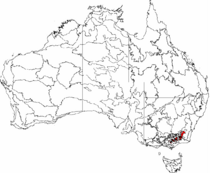Ngarigo facts for kids
Quick facts for kids Ngarigo people |
|
|---|---|
| aka: Ngarigo, Bombala tribe, Menero tribe, and Cooma tribe | |

Australian Alpine bioregion
|
|
| Hierarchy | |
| Language family: | Pama–Nyungan |
| Language branch: | Yuin–Kuric |
| Language group: | Yora |
| Group dialects: | Ngarigu |
| Area | |
| Location: | Monaro and Australian Alpine regions of New South Wales and Victoria |
| Rivers | |
| Urban areas |
|
The Ngarigo people are an Aboriginal Australian group. They traditionally lived in the southeast of New South Wales. Their lands also stretched across the border into Victoria. You might see their name spelled in different ways, like Garego, Ngarego, or Ngarigu.
Contents
Ngarigo Language and Its Speakers
The Ngarigo people speak the Ngarigo language. A language expert named Robert M. W. Dixon said it was one of two main Aboriginal languages in Southern New South Wales. The other was Ngunawal/Gundungurra.
Where Ngarigo Was Spoken
The Ngarigo language was spoken in several areas. This included the Tumut region by the Walgalu people. It was also heard around Canberra, Queanbeyan, and the Upper Murrumbidgee area. Some speakers lived as far south as the Omeo district in Victoria. The main area for Ngarigo speakers was the Monaro region.
Recording the Language
Many people helped record the Ngarigo language long ago. These included John Lhotsky, Charles du Vé, and George Augustus Robinson. Later, in 1963, Luise Hercus found many words still remembered by Ngarigo descendants. They were living in Orbost.
Traditional Ngarigo Lands
The traditional lands of the Ngarigo people covered a large area. It was about 16,000 square kilometers (6,178 square miles). The center of their country was the Monaro tableland.
Boundaries of Their Country
To the north, their land reached near Queanbeyan. It included the area around the Bombala River. Their country went south towards Delegate. To the east, it stretched to Nimmitabel. The western edge of their lands reached the Great Dividing Range in the Australian Alps.
Ngarigo Community Life
The Ngarigo people had a special way of organizing their families and marriages. They used a "dual class system." This meant that children belonged to their mother's family group.
Gatherings and Ceremonies
The Ngarigo would send messages to other groups. They used special message sticks carried by messengers. This helped them arrange meetings with tribes like the Walgalu and Ngunawal. They would all meet in the Bogong Mountains. Here, they would have a big annual feast. They ate Bogong moths, which were plentiful.
They also held special gatherings called Corroborees. These included initiation ceremonies at a bora ring. While in the mountains, the Ngarigo and other tribes collected plants. They used plants like mountain celery and alpine baeckea. These plants were used for medicine. For example, mountain celery was made into a paste for health issues. Alpine baeckea was used as a calming medicine and for coughs.
Ngarigo History After European Arrival
When European settlers arrived, they used Ngarigo hunting areas for sheep farming. This meant the Ngarigo people lost their traditional food sources. Many Ngarigo then worked on farms for a living.
Impact of New Diseases
Sadly, the Ngarigo population in the Canberra area dropped a lot. This was because Europeans brought new diseases. Illnesses like smallpox, influenza, measles, and tuberculosis spread. These diseases caused many deaths. The traditional way of life for the tribes changed greatly within just three generations.
Who Are the Traditional Owners of Canberra?
The area around Canberra has been linked to several Aboriginal groups. This has led to some disagreements about who the "First People" of Canberra are. Descendants of the Ngarigo, Ngunawal, and Walgalu peoples have all said they are the original owners.
Report on Traditional Ownership
In 2013, a report was released by the ACT Government. It looked into the history of Aboriginal groups in Canberra. The report said it was hard to be sure which family group had the strongest claim. This was because there wasn't enough clear evidence from the mid-1800s onwards.
Other Names for the Ngarigo People
The Ngarigo people were known by several other names, including:
- Bemeringal (meaning "mountain men" by coastal tribes)
- Bombala tribe
- Bradjerak/Brajeraq (meaning "savage/angry man")
- Cooma tribe
- Currak-da-bidgee
- Guramal, Nguramal, Gurmal
- Menero tribe
- Murring (meaning "men")
- Ngaryo (a common misspelling)
Notable Ngarigo People
- Ashleigh Barty (born 1996) is a famous Ngarigo woman. She was once the World No. 1 tennis player. She is also the National Indigenous Tennis Ambassador for Tennis Australia. Ashleigh won major tennis tournaments, including the 2019 French Open, the 2021 Wimbledon Championships, and the 2022 Australian Open. In February 2022, she proudly wrote on Instagram, "I’ve never been so proud to be a Ngarigo woman."

